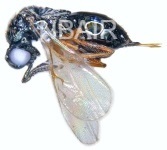Scientific name
Asaphes Walker, 1834
Taxonomic position
Hymenoptera: Chalcidoidea: Pteromalidae
Diagnosis
Fore wing with marginal vein at most 1.3 times as long as the stigmal vein; postmarginal vein longer than the marginal vein. Occiput margined. Dorsal surface of hind coxae hairy in the basal half. Anterior margin of clypeus truncate. Second tergite of gaster at least half as long as first. Antennal formula 11263. Genae bordered by a strong carina which extends to temples. Frenal groove of scutellum strongly impressed. Gaster with petiole quadrate or slightly longer than broad; basal tergite with only a very few hairs, at base, on either side of the petiolar insertion.
Image
 Adult - lateral view Adult - lateral view
Distribution
India: Kashmir, Punjab, Himachal Pradesh, Uttar Pradesh, Meghalaya and Karnataka.
Two species recorded from India: Asaphes suspensus (Nees, 1834) and Asaphes vulgaris Walker, 1834.
Biology / Hosts
Primary hosts - Aphididae and Syrphidae. Hyperparasitic on Aphelinidae (Aphelinus), Braconidae (Aphidius , Diaretiella rapae etc.)
References
- Gibson, G.A.P. and Vikberg, V. 1998. The species of Asaphes Walker from America north of Mexico, with remarks on extralimital distributions of taxa (Hymenoptera: Chalcidoidea, Pteromalidae). Journal of Hymenoptera Research 7(2) pp. 209-256.
- Graham, M.W.R. de V. 1969. The Pteromalidae of north-western Europe (Hymenoptera: Chalcidoidea). Bulletin of the British Museum (Natural History) (Entomology) Supplement 16 pages: 908 pp, 686 figs.
- Nees ab Esenbeck, C.G. 1834. Hymenopterorum Ichneumonibus affinium, Monographiae, genera Europaea et species illustrantes 2:127 Stuttgart und Tübingen.
- Noyes, J.S. 2015. Universal Chalcidoidea Database. World Wide Web electronic publication.http://www.nhm.ac.uk/chalcidoids.
- Sureshan, P.M. & Narendran, T.C. 2004. Key to the genera of Pteromalidae of India and the adjacent countries (Hymenoptera: Chalcidoidea). Rec. Zool. surv. India. Occ. Paper No. 229: 1-56.
- Walker, F. 1834. Monographia Chalciditum. (Continued.) Entomological Magazine 2(2):151.
|